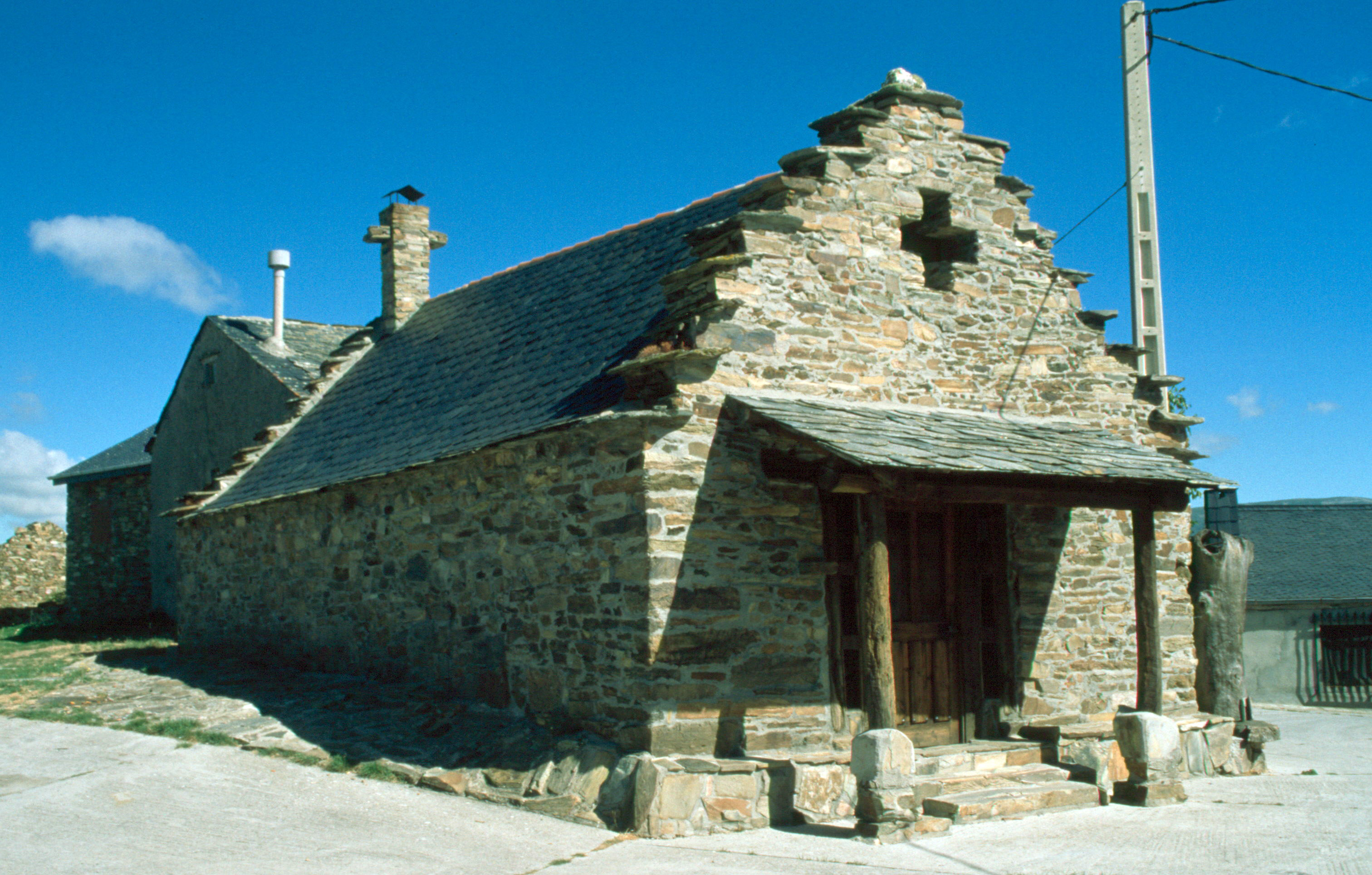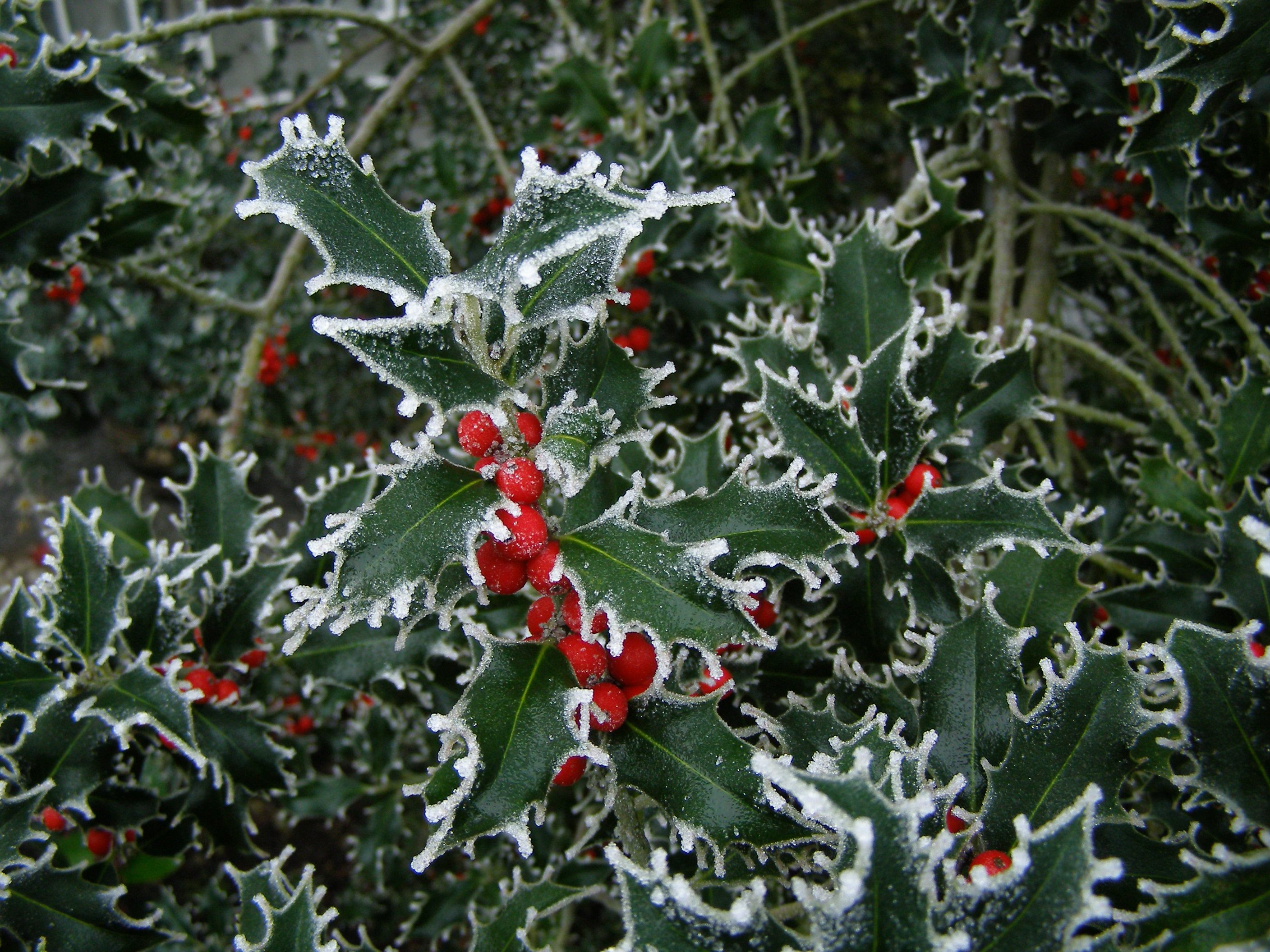|
El Acebo
El Acebo is a very small village on the Camino de Santiago in the Province of León in the Autonomous community of Castille-León. The village is named after the European Holly. The village is typical of mountain villages of upper Bierzo, with houses built from and covered in slate (the typical building material of the region). Another characteristic of the homes are the street-facing wooden balconies, that sometimes reach outside of an outdoor staircase. According to oral tradition the residents in the Middle Ages were against installation and maintenance of 800 stakes to mark the pilgrimage route (which is especially important in this area due to snow), which came as tribute from the king. Like in other villages along the Camino de Santiago, the revival of the Camino de Santiago improved the economic basis of the villages: Next to communal and private hostels there are holiday houses known as Casas Rurales, as well as a grocery that had reopened. These is also a restaurant. ... [...More Info...] [...Related Items...] OR: [Wikipedia] [Google] [Baidu] |
List Of Sovereign States
The following is a list providing an overview of sovereign states around the world with information on their status and recognition of their sovereignty. The 206 listed states can be divided into three categories based on membership within the United Nations System: 193 UN member states, 2 UN General Assembly non-member observer states, and 11 other states. The ''sovereignty dispute'' column indicates states having undisputed sovereignty (188 states, of which there are 187 UN member states and 1 UN General Assembly non-member observer state), states having disputed sovereignty (16 states, of which there are 6 UN member states, 1 UN General Assembly non-member observer state, and 9 de facto states), and states having a special political status (2 states, both in free association with New Zealand). Compiling a list such as this can be a complicated and controversial process, as there is no definition that is binding on all the members of the community of nations concerni ... [...More Info...] [...Related Items...] OR: [Wikipedia] [Google] [Baidu] |
Bierzo
El Bierzo (; ; gl, O Bierzo) is a ''comarca'' in the province of León, Spain. Its capital is the town of Ponferrada. Other major towns are Bembibre and Villafranca del Bierzo, the historical capital. The territory of El Bierzo includes most of the upper basin of the Sil river. It is surrounded by mountains on all sides, which makes this area remarkably isolated from all neighbouring lands. History In pre-Roman times the region was populated by the Astures, a Hispano-Celtic Gallaecian people. They were conquered by Emperor Augustus in the Astur-Cantabrian Wars (29–19 BC) and the area quickly became the largest mining center of the Empire during the Roman period, where gold and other metals and minerals were extracted. Numerous Roman mining sites are still visible in the area, one of the most spectacular being Las Médulas, a UNESCO World Heritage Site since 1997. Romans also imported grapevines, and wine production thrived in the region until the propagation o ... [...More Info...] [...Related Items...] OR: [Wikipedia] [Google] [Baidu] |
Pelagius Of Asturias
Pelagius (; ; ; ; ''c''. 685 – 737) was a Hispano-Visigoth nobleman who founded the Kingdom of Asturias in 718. Pelagius is credited with initiating the ''Reconquista'', the Christian reconquest of the Iberian Peninsula from the Moors, and establishing the Asturian monarchy, making him the forefather of all the future Iberian monarchies, including the Kings of Castile, the Kings of León, and the Kings of Portugal. Early life Pelagius was a Visigoth nobleman, the son of Fafila. The ''Chronica Albeldense'' says that this Fafila was a ''dux'' of Gallaecia, who was killed by Wittiza. The ''Chronicle of Alfonso III'' identifies Pelagius as a grandson of Chindasuinth and says that his father was blinded in Córdoba, at the instigation of Wittiza. Wittiza is also said to have exiled Pelagius from Toledo upon assuming the crown in 702. In the opinion of Roger Collins, this is a late tradition and the account of the ''Albeldense'', which locates Pelagius' origins in the north of the pe ... [...More Info...] [...Related Items...] OR: [Wikipedia] [Google] [Baidu] |
Molinaseca
Molinaseca is a village and municipality located in the region of El Bierzo (province of León, Castile and León, Spain) . According to the 2010 census (INE), the municipality has a population of 818 inhabitants. It is located on the French Way, the most popular path of the Camino de Santiago. Sister cities * Ainan, Japan * Águas de São Pedro, Brazil Brazil ( pt, Brasil; ), officially the Federative Republic of Brazil (Portuguese: ), is the largest country in both South America and Latin America. At and with over 217 million people, Brazil is the world's fifth-largest country by area ... References Municipalities in El Bierzo Populated places in the Province of León {{León-geo-stub ... [...More Info...] [...Related Items...] OR: [Wikipedia] [Google] [Baidu] |
Rebar
Rebar (short for reinforcing bar), known when massed as reinforcing steel or reinforcement steel, is a steel bar used as a Tension (physics), tension device in reinforced concrete and reinforced masonry structures to strengthen and aid the concrete under tension. Concrete is strong under Compression (physics), compression, but has weak tensile strength. Rebar significantly increases the tensile strength of the structure. Rebar's surface features a continuous series of ribs, lugs or indentations to promote a better bond with the concrete and reduce the risk of slippage. The most common type of rebar is carbon steel, typically consisting of hot-rolled round bars with deformation patterns embossed into its surface. Steel and concrete have similar coefficient of thermal expansion, coefficients of thermal expansion, so a concrete structural member reinforced with steel will experience minimal differential stress (mechanics), stress as the temperature changes. Other readily available ... [...More Info...] [...Related Items...] OR: [Wikipedia] [Google] [Baidu] |
James, Son Of Zebedee
James the Great, also known as James, son of Zebedee, Saint James the Great, Saint James the Greater, Saint James the Elder, or Saint Jacob (Aramaic ܝܥܩܘܒ ܒܪ ܙܒܕܝ, Arabic يعقوب, Hebrew בן זבדי , '' Yaʿăqōḇ'', Latin ''Iacobus Maior'', Greek Ἰάκωβος τοῦ Ζεβεδαίου ''Iákōbos tû Zebedaíou''; died AD 44), was one of the Twelve Apostles of Jesus, the first apostle to be martyred according to the New Testament. Saint James is the patron saint of Spain and, according to tradition, his remains are held in Santiago de Compostela in Galicia. In the New Testament The son of Zebedee and Salome, James is styled "the Greater" to distinguish him from the Apostle James "the Less", with "greater" meaning older or taller, rather than more important. James the Great was the brother of John the Apostle. James is described as one of the first disciples to join Jesus. The Synoptic Gospels state that James and John were with their father by the ... [...More Info...] [...Related Items...] OR: [Wikipedia] [Google] [Baidu] |
Polychrome
Polychrome is the "practice of decorating architectural elements, sculpture, etc., in a variety of colors." The term is used to refer to certain styles of architecture, pottery or sculpture in multiple colors. Ancient Egypt Colossal statue of Tutankhamun Paris 2019 A.jpg, Polychrome quartzite colossal statue of Tutankhamun, 1355-1315 BC Nofretete Neues Museum.jpg, Polychrome limestone and plaster ''Bust of Nefertiti'', 1352–1336 BC Composite Papyrus Capital MET 10.177.2 EGDP018080.jpg, Polychrome sandstone Composite papyrus capital, 380–343 BC Medinet Habu 2016-03-23g.jpg, Polychrome winged sun on a cavetto from the Medinet Habu temple complex, unknown date Classical world Some very early polychrome pottery has been excavated on Minoan Crete such as at the Bronze Age site of Phaistos. In ancient Greece sculptures were painted in strong colors. The paint was frequently limited to parts depicting clothing, hair, and so on, with the skin left in the natural co ... [...More Info...] [...Related Items...] OR: [Wikipedia] [Google] [Baidu] |
Michael (archangel)
Michael (; he, מִיכָאֵל, lit=Who is like El od, translit=Mīḵāʾēl; el, Μιχαήλ, translit=Mikhaḗl; la, Michahel; ar, ميخائيل ، مِيكَالَ ، ميكائيل, translit=Mīkāʾīl, Mīkāl, Mīkhāʾīl), also called Saint Michael the Archangel, Saint Michael the Taxiarch in Orthodoxy and Archangel Michael is an archangel in Judaism, Christianity, Islam and the Baha'i faith. The earliest surviving mentions of his name are in 3rd- and 2nd-century BC Jewish works, often but not always apocalyptic, where he is the chief of the angels and archangels and responsible for the care of Israel. Christianity adopted nearly all the Jewish traditions concerning him, and he is mentioned explicitly in Revelation 12:7–12, where he does battle with Satan, and in the Epistle of Jude, where the author denounces heretics by contrasting them with Michael. Second Temple Jewish writings The earliest surviving mention of Michael is in a 3rd century BC Jewish ... [...More Info...] [...Related Items...] OR: [Wikipedia] [Google] [Baidu] |
Ilex Aquifolium
''Ilex aquifolium'', the holly, common holly, English holly, European holly, or occasionally Christmas holly, is a species of flowering plant in the family (botany), family Aquifoliaceae, native plant, native to western and southern Europe, northwest Africa, and southwest Asia.Flora Europaea''Ilex aquifolium''/ref>Med-Checklist''Ilex aquifolium''/ref>Rushforth, K. (1999). ''Trees of Britain and Europe''. Collins .Flora of NW Europe''Ilex aquifolium'' It is regarded as the type species of the genus ''Holly, Ilex'', which by association is also called "holly". It is an evergreen tree or shrub found, for example, in shady areas of forests of oak and in beech hedges. In the British Isles it is one of very few native hardwood evergreen trees. It has a great capacity to adapt to different conditions and is a pioneer species that repopulates the margins of forests or clearcuts. ''I. aquifolium'' can exceed 10 m in height, but is often found at much smaller heights, typically tall and b ... [...More Info...] [...Related Items...] OR: [Wikipedia] [Google] [Baidu] |
Autonomous Communities Of Spain
eu, autonomia erkidegoa ca, comunitat autònoma gl, comunidade autónoma oc, comunautat autonòma an, comunidat autonoma ast, comunidá autónoma , alt_name = , map = , category = Autonomous administrative division , territory = , upper_unit = , start_date = 1979–1983 , legislation_begin = Spanish Constitution of 1978 , legislation_end = , end_date = , current_number = 17 autonomous communities 2 autonomous cities , number_date = , type = , status = , exofficio = , population_range = Autonomous communities:319,914 (La Rioja) – 8,464,411 (Andalusia)Autonomous cities:84,202 (Ceuta) – 87,076 ( Melilla) , area_range = Autonomous communities:4,992 km2 ( Balearic Islands) – 94,223 km2 ( Castile and León)Autonomous cities:12.3 km2 ( Melilla) – 18.5 km2 (Ceuta) , government = Autonomous government , subdivision = Prov ... [...More Info...] [...Related Items...] OR: [Wikipedia] [Google] [Baidu] |
Camino De Santiago
The Camino de Santiago ( la, Peregrinatio Compostellana, "Pilgrimage of Compostela"; gl, O Camiño de Santiago), known in English as the Way of St James, is a network of pilgrims' ways or pilgrimages leading to the shrine of the apostle Saint James the Great in the cathedral of Santiago de Compostela in Galicia in northwestern Spain, where tradition holds that the remains of the apostle are buried. As Pope Benedict XVI said, "It is a way sown with so many demonstrations of fervour, repentance, hospitality, art and culture which speak to us eloquently of the spiritual roots of the Old Continent." Many follow its routes as a form of spiritual path or retreat for their spiritual growth. It is also popular with hiking and cycling enthusiasts and organized tour groups. Created and established after the discovery of the relics of Saint James the Great at the beginning of the 9th century, the Way of St James became a major pilgrimage route of medieval Christianity from the 10th cent ... [...More Info...] [...Related Items...] OR: [Wikipedia] [Google] [Baidu] |










.jpg)